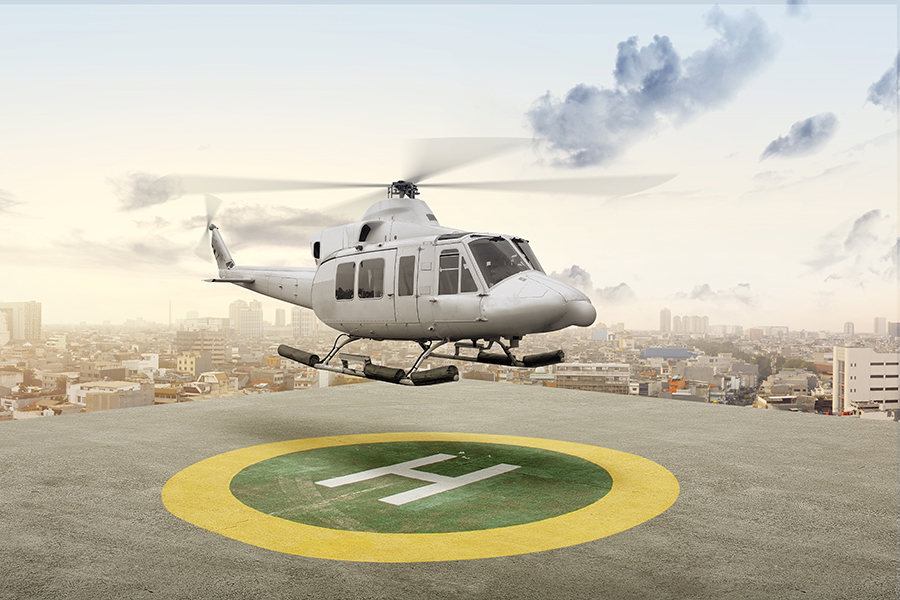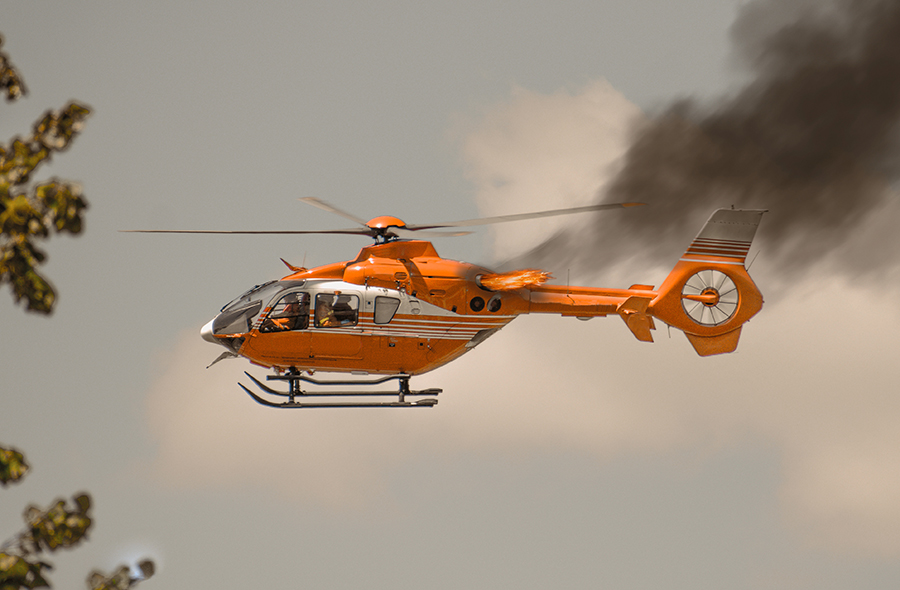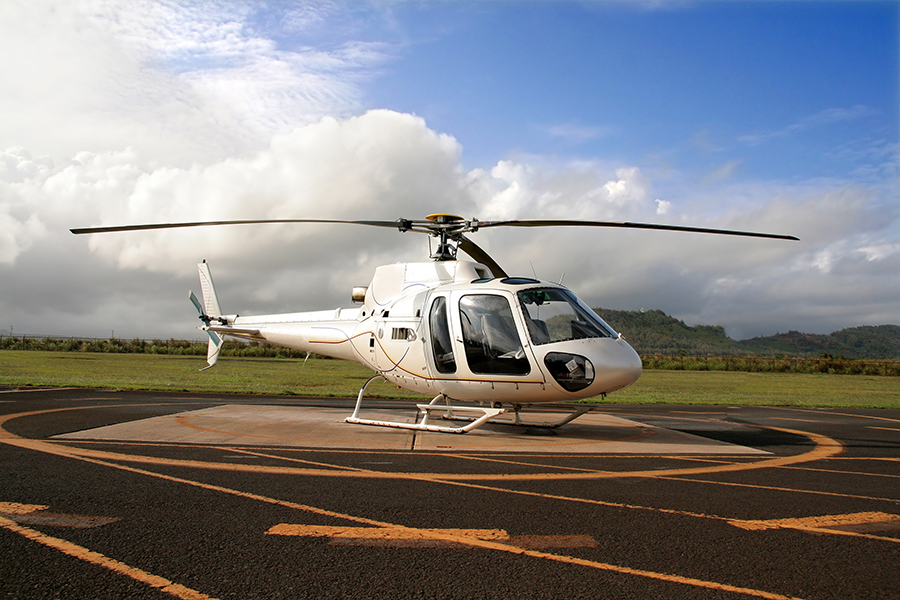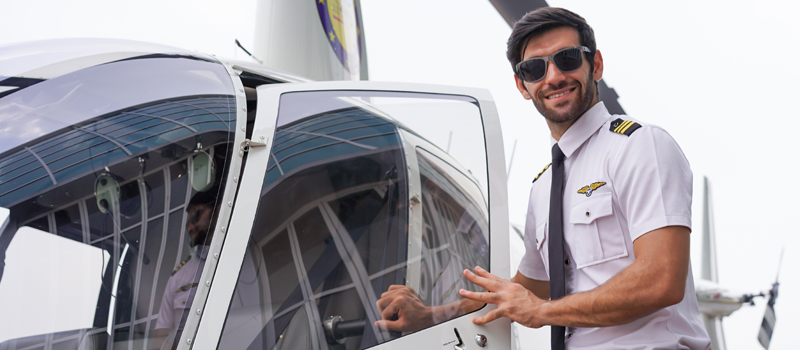When an aircraft taxis out to the runway, accelerates along with it, and then leaves the ground and starts to fly, we call this a ‘take-off”, don’t we? However, the terminology is a little different if the aircraft is a helicopter. So let’s take a look at that first, to make sure we know what we are talking about.
In a rotary aircraft, strictly speaking, the take-off occurs when the pilot lifts the machine off the ground into hover. This is the only part that is conventionally called a take-off. The process of accelerating from hover to forward flight has a different name that is specific to helicopters. It is actually called a ‘transition’. This is worth mentioning, as you may read accounts that talk of a helicopter ‘transitioning away’, and this might be confusing. All it means is that the helicopter left the airfield and started flying.
However, in this article, we will look at the whole process of the helicopter going from being stationary to it being airborne and forwarding flight. In traditional terminology, we will discuss both the ‘take-off’ and the ‘transition’.
Normal Take-offs
We will first describe the usual way to go from being stationary on the ground, to forward flight, ie a normal take-off.
Lifting The Helicopter Into The Hover
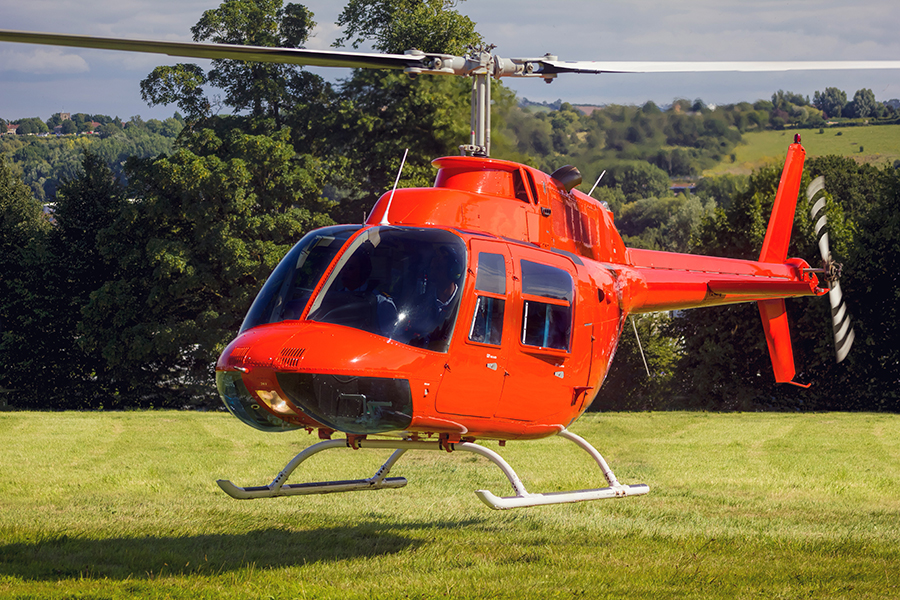
You might think that lifting a helicopter into a hover a few feet above the ground would be easy. Can’t you simply raise the collective, keep the machine straight with the pedals, and that’s it? No, there is more to it than that. Lifting a helicopter off the ground must be done with great care. The pilot needs to raise the collective very slowly until the helicopter is light on the skids, then position the cyclic to ensure that take-off will be precisely vertical, before raising the collective further. If at all possible, the pilot should ensure that both skids lift off at exactly the same time.
If the take-off is done too fast or carelessly, or not as described above, the helicopter may get into what is called ‘dynamic rollover’. Without going into too much detail, dynamic rollover is when a helicopter turns itself over instead of lifting into the hover. It then proceeds to crash. This can occur quite easily if the helicopter’s center of gravity is displaced while power is being applied, as occurs during take-off.
To avoid the possibility of a dynamic rollover occurring, students practice take-offs extensively before going solo in a helicopter, since the take-off is one of the most difficult things they will have to do. In addition, great care should be taken to ensure that one skid is not stuck in the mud, in long grass, or on ice, since any of these things can very easily induce dynamic rollover.
If the pilot realizes that the helicopter is not taking off absolutely vertically, he should not continue the take-off but should lower the collective, put the helicopter back on the ground, and start again.
Starting The Transition To Forward Flight
In transitioning from hover to forward flight there are a number of important issues which the pilot needs to consider, probably rather more than his fixed-wing counterpart. This is due to the fact that hovering and forward flight are two very different ways of flying a helicopter, and there are several quite complex aerodynamic factors that need to be borne in mind when changing from one to the other.
To start the transition from hover to forward flight, the pilot simply moves the cyclic forward, which causes the helicopter to move forward and accelerate. However, when a helicopter is hovering, the air is being drawn down through the rotor system, and it collects beneath the hovering helicopter. This so-called ‘ground cushion’ of air means that slightly less power is needed to hover close to the ground than would otherwise be the case. But when the helicopter is moved forward from the hover, it literally falls off the cushion of air. Therefore it starts to sink, and it is necessary for the pilot to raise the collective a little to maintain height.
Continuing The Transition To Forward Flight
The next thing that happens as the aircraft moves forward is that it begins to roll to the right so that a little left cyclic is required. This is due to different amounts of lift being produced at different points along with the rotor blades at very low airspeeds, although the exact theoretical reason is somewhat more complicated than this. In practice ‘inflow roll’, as it is called, is a very small effect, if it occurs at all. Many pilots are never aware of it, so it is probably not something you generally need to worry about.
As the transition is continued, and the helicopter picks up speed, the next effect which occurs is called ‘flapback’. When the cyclic is moved forward, the ‘rotor disc’, which is the hypothetical disc the rotors make when they are rotating, tilts forward and down, and this is what causes the helicopter to move forward. However, owing to the dissymmetry of the lift – and again, the details are quite complex – the disc tends to try to flap back to its original position. This means in practice that although a forward movement of the cyclic initially causes the helicopter to speed up, that acceleration will very quickly cease unless the pilot continues to move the cyclic forward. So constant forward pressure on the cyclic is required, or, as the instructor will probably urge the student when he or she is learning, “push through flapback”.
The next aerodynamic effect which happens is called ‘translational lift’. At around 12- 15 knots of airspeed, some of the air which is being sucked down into the rotor system is blown away horizontally, and this means that more air is available to help the helicopter climb. In other words, it is like a free lift, and this is one of the few occasions when you get something for nothing! However, at this point in the transition, we don’t want the helicopter to climb. Helicopters accelerate close to the ground if at all possible, and only take off vertically or nearly so if they absolutely have to, to avoid trees or other obstacles. This is for safety reasons so that if the engine were to fail at any point, the pilot could more easily land the helicopter safely. This would be very difficult if the helicopter were to be high and slow, so you accelerate to a safe flying speed close to the ground, then allow the helicopter to climb.
Therefore, when translational lift occurs, the pilot pushes the cyclic forward to convert lift energy into forward airspeed, while keeping close to the ground. At around 45 knots, which is a safe flying speed, he or she eases back on the cyclic and allows the helicopter to climb, then pushes the cyclic forward a little to select the usual climb speed of 60 knots. At this point, the helicopter will tend to yaw left due to the fact that the tail fin is more efficient at higher airspeeds. It will also tend to roll left. Therefore both the right cyclic and right pedal will be required.
That is the take-off and transition completed, and the helicopter is now in forward flight. Reading this for the first time, you might well think that this transition to forward flight requires incredibly fast reactions and the ability to do several things at the same time. However, the transition to forward flight is one maneuver that is actually far more difficult to describe than to do. In practice, the pilot brings the helicopter to a hover, looks well ahead, then moves the cyclic forward. He or she then adjusts all the controls as much or as little as is required until the helicopter is in forward flight. It is possible to do this without much real knowledge of the aerodynamic factors involved, and in fact, most of the necessary corrections soon become quite instinctive and natural.
Advanced Or Unusual Take-offs
There are some situations in which take-offs are somewhat modified. We will take a look at those now.
Taking Off On Sloping Ground
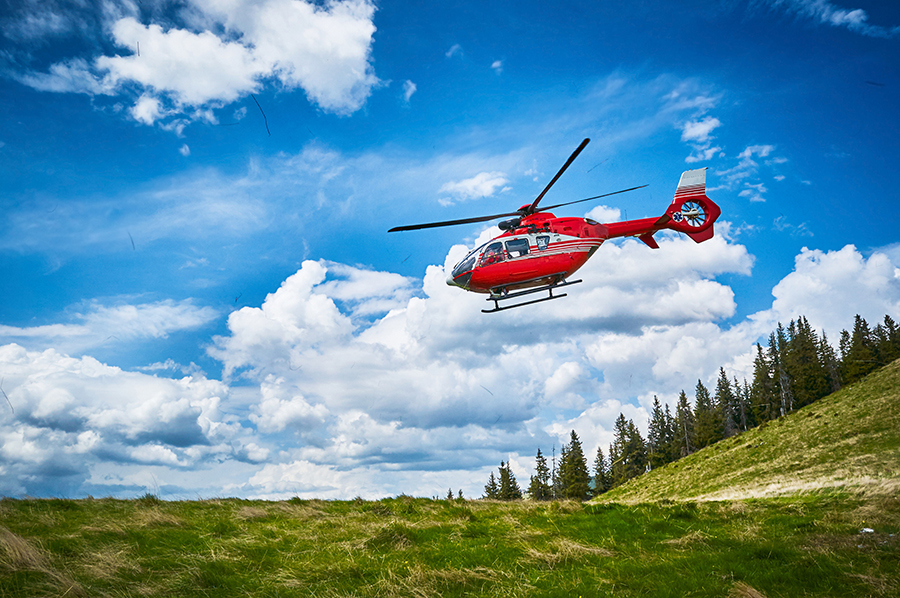
Despite their reputation with the public as all-terrain vehicles that can take off and land almost anywhere, helicopters really are not all that good on slopes. Even slightly sloping ground requires a special technique if the helicopter is to be operated safely.
So what are the difficulties associated with the sloping ground? Basically, the problem is that if you take off in the normal way, the helicopter will not be vertical. So it is more likely to enter dynamic rollover (described above) and crash!
To take off safely, on even slightly sloping ground, the cyclic is moved to the uphill side of the slope so that the rotor disc is horizontal. Then the collective is raised smoothly and carefully, with the cyclic gradually being centered as the downhill skid leaves the ground. The helicopter must lift off vertically, but the pilot must not let the second skid leave the ground until the rotor disc is level.
Then, after leaving the ground, the pilot must ensure that the helicopter has reached a suitable height before he attempts to turn or do any other maneuvers, to make certain that the helicopter tail does not strike the ground. Then, and only then, can he do the transition, in the same way as normal?
Sloping ground take-offs (and landings) are not easy. Indeed, they are one of the last lessons in the Helicopter Private Pilots’ License syllabus, and in many students’ opinion, they are the most difficult exercise of all. For obvious reasons they are not taught until the new pilot has completely mastered the hover. I remember learning them myself, and while I was certain before doing the exercise that I could hover steadily in any situation, the sloping ground operations exercise really knocked my confidence. It seemed to require a degree of coordination and judgment that I thought I did not have at the time, and I felt that I never would. But of course, this was not the case. As with everything else in aviation, hovering ability improves with practice, and eventually taking off and landing on slopes no longer seems the insurmountable obstacle that it can appear to the new helicopter pilot. But it always takes great care and concentration.
Operating on very slight slopes is something that every helicopter pilot learns if he or she takes a helicopter to almost any off-airfield site. Such places are rarely completely flat, so unless landing on a prepared surface such as at an airfield, students are taught to consider any landing as a sloping ground unless clearly proved otherwise. Long grass can hide slopes or small holes, and rain or mud can mean a normally level surface is no longer as it used to be.
It should now be clear why helicopter pilots always try to land somewhere reasonably flat if at all possible. This is not all that difficult during the sort of trips that most private pilots tend to do. Even landing at a private site or in a confined area, there is often a small area which is level. Therefore the ordinary Private Pilot tends not to use sloping ground techniques all that frequently.
Taking Off In A Confined Area
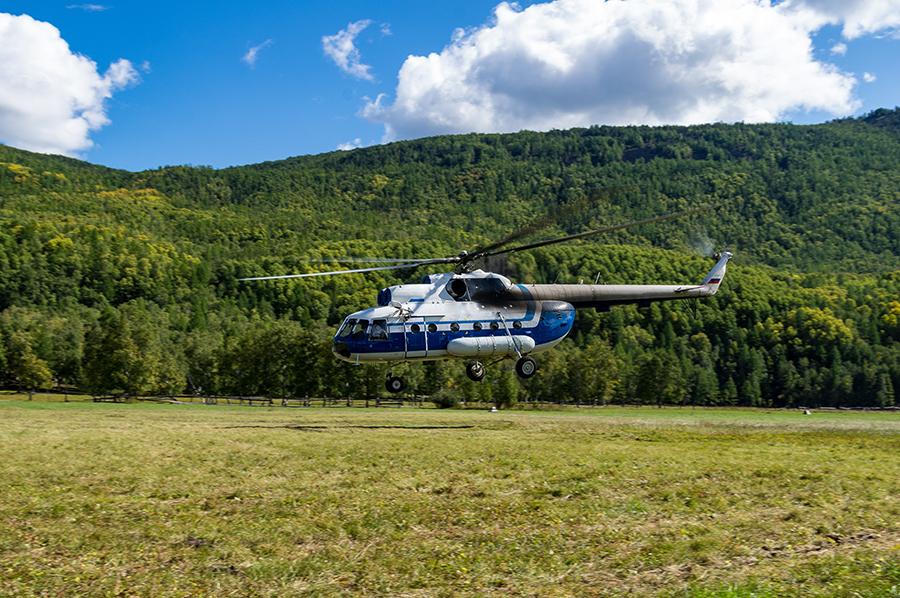
Helicopters are sometimes unable to do the conventional take-off and transition due to lack of space. In a ‘confined area’, which is any area without enough room for a normal transition, the flight of the helicopter is limited by obstacles. Every confined area is different, so details of how to do confined area take-offs need to be adaptable. Confined area operations are actually quite difficult and can be dangerous, for there are a great many things that can go wrong. For this reason, the confined area exercise is one of the very last in the helicopter private pilot syllabus,
The main potential problem is that of needing to lift off vertically or nearly so, in order to avoid obstacles. Helicopters can do this of course. But it isn’t particularly easy, and it isn’t recommended, as it would be very difficult to land safely should the engine happen to fail during the take-off. This is admittedly very unlikely, but safety is always a primary consideration in helicopter flying.
Helicopters do take off vertically when they have to if it is necessary to avoid obstacles. This is called a ‘towering take-off’. The first thing the pilot has to do is check carefully around him, to be sure he knows where all the obstacles and hazards are. Then after starting up, you need to check your power margins carefully, as towering take-offs need a great deal of power. It is better to drop off a passenger before you start and pick them up elsewhere, rather than finding that you don’t have enough power to clear the trees or other obstacles.
If you need to do a towering take-off, you first need to pick some lateral markers. These are points or objects on the ground which enable you to ensure that you are indeed taking off vertically, and not veering off to one side….potentially into an obstacle. It is actually quite difficult to lift off vertically without doing this.
Once high enough to be clear of all obstacles, you can move the cyclic forward and transition away from it as usual.
Taking Off Out Of Wind
Most take-offs and transitions are done facing into the wind, as for a fixed-wing aircraft. This is by far the easiest direction.
However, just occasionally you need to do a take-off crosswind or downwind. For these, you lift off the ground in the normal way, but the transition to forward flight is slightly different. So you raise the helicopter into the hover as usual. You then ease the cyclic forward very, very slowly. The main problem at this point is that the wind will blow you forward, but your airspeed will actually decrease for a while until the groundspeed is the same as the wind speed. This may be easier to understand if some numbers are used. Suppose the wind is blowing at a speed of 10 knots, then, as you lift into the hover, you have a rearwards airspeed of 10 knots. However, as the helicopter moves forward, this airspeed decreases, so that when your groundspeed forward is 10 knots, your airspeed is actually zero. Only then will the forward airspeed start to increase, but it will take you far, far longer than usual to acquire translational lift and have enough airspeed to be able to climb away safely.
You might find this explanation of a downwind or crosswind take-off quite hard to follow in theory. But in practice, it just means that you need a great deal of power and that the power requirements of the helicopter increase initially since your airspeed is decreasing…remember that more power is needed to hover with zero airspeed. In addition, your transition to forward flight will cover a great deal of space, since it is taking you so long to reach safe flying speed. So you don’t do an out of wind take-off unless you have a long runway or the equivalent amount of room. I still remember the first time I tried this as a student, and I was amazed at just how much I needed to raise the collective to keep from hitting the ground. I could also hardly believe how great a distance we covered over the ground. But gradually you will pick up speed, and when you reach translational lift speed the power requirements will lessen so that you can then start to climb away as normal.
Taking Off At High Altitude
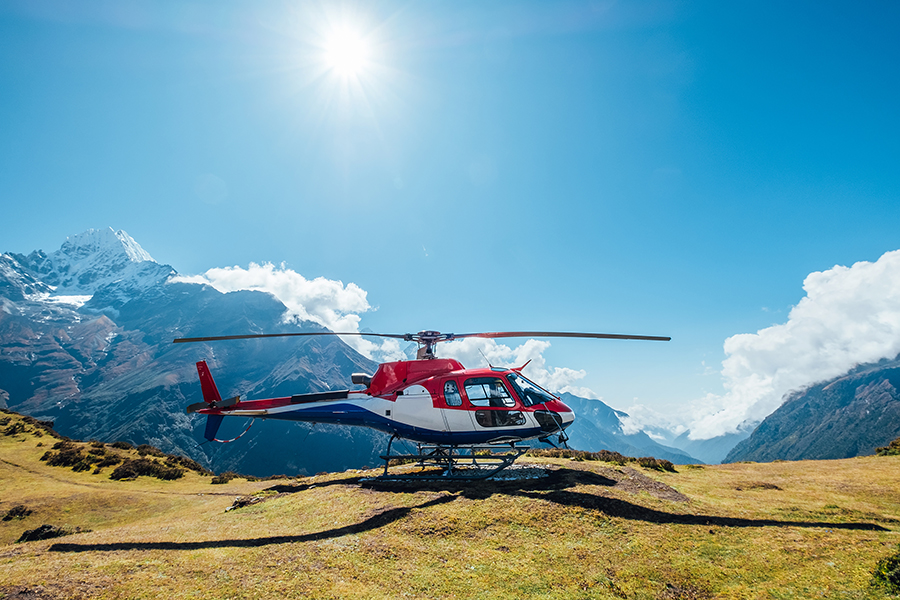
There can be a problem with taking off at a high altitude, for instance in the mountains, due to the fact that less power will be available for the helicopter to use. So a special technique is used. Instead of lifting into the hover, you only raise the collective until the helicopter is just light on its skids, while still on the ground. You will then push the cyclic gently forward so that the helicopter runs along the ground, gradually picking up speed until translational lift speed is attained. At this point the helicopter will be able to fly, so you can gently transition away into a climb. This is known as a ‘running take-off’. It is quite similar to a fixed-wing take-off, so fixed-wing pilots usually find it quite easy.
The transition, once the translational lift is attained, is the same as normal.
Conclusion
This is a necessarily brief explanation of helicopter take-offs and transitions. If you are reading this and thinking that you’ll never be able to fly well enough to take off confidently downwind, in a really tight confined area, on a mountain, or on a slope, please don’t worry. Many private pilots rarely if ever need to use these advanced take-off maneuvers. The normal take-off and transition is what you will use almost all the time.
One of the few times I’ve used these more advanced techniques was when I was flying with an extremely gung-ho ex-military instructor, during advanced training for my Commercial Helicopter Pilots’ License. The instructor persuaded me to come down vertically into a tiny clearing in the forest, between tall trees, on sloping ground. I then had to do a sloping ground take-off, with wires right across our departure path. I managed it of course! But that is another story…
